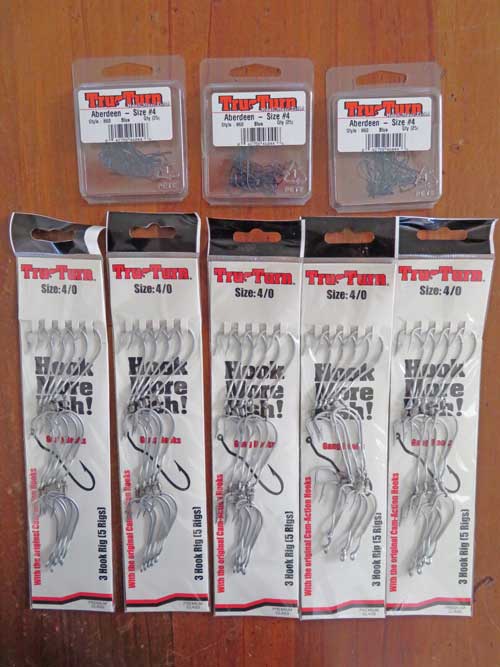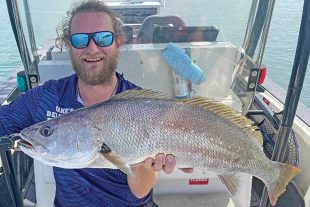Well, with the colder weather coming through in May, the cooler-water species have definitely hit their straps, along with a couple of year-round favourites.
So here’s a summary of a few of the popular targets in Moreton Bay and its surrounding islands.
Tailor
Over the past couple of years, tailor were very hit and miss in southeast Queensland, however this year has started as a beauty.
The beaches along the Gold Coast have produced a number of good sessions on bait and lures, as have North and South Stradbroke islands and even Bribie Island.
And there’s also been an increase in catches as far as K’gari, when the sea settled and weed dispersed.
Matt Melgaard from the Redland Bay Amateur Fishing Club told me their club had an awesome weekend around the full moon, with great day catches of tailor and some very big fish to 75cm at night.

What I love about this club is hearing that they cut bag limits for anglers right back, with eight fish the bag for tailor.
As winter progresses, the best conditions for tailor are a light swell and a westerly wind.
A westerly calms the sea down and brings baitfish close to shore to seek protection.
And the tailor soon follow.
There were also plenty of catches throughout the bay, including the entrances, though even along bayside rock walls.

Anglers who used gang pilchard and small metals off the rock walls, or trolling around bait schools or birds working in the bay, had success.
When bait fishing for tailor, I love using the Tru-Turn Swivel Gang Hooks in a size 4/0.
The swivels in between the hooks make hanging up so much easier than stiff hooks ganged together, and their offset shanks provide great hook-ups, as they turn upwards into the fish’s mouth when pressure is applied.
While there are many lures you could use, two inexpensive metals include the gold and silver Halco Twisty in 40g and 55g for off the beach or 15-40g for off the rock walls and the Surecatch Knight, with blue my favourite colour for this lure.

In terms of hard-bodies, weighted bibless lures to 42g are awesome off the beach, and you can also use weighted poppers in deep gutters with only a light swell and white water covering.
Trolling wise, Rapala, Duel, RMG, Halco, Zerek Zappelin, Duo Minnow and others in blue, green and silver shades with a bit of flash on the side that dive 4-5m are great options.
Winter whiting
While colloquially called ‘winter’ whiting, this species can be caught throughout Moreton Bay all year round.
Though they tend to move.
Over the past month or so, big schools have moved in over the shallow banks, and I’m talking in about 1.2-1.5m of water.
My preferred days are those with a very light breeze and a little cloud for some protection for the fish, but don’t rule out those magic clear winter days, though occasionally they may move to water a little deeper.
My general rule is, if I start catching small reef fish, I’m too deep.
The same for grinners – if you catch some, move because these thieves will attack your bait and your fish!

On a recent trip, I had a number of squid follow my whiting on the weedy sand flats and even managed to scoop one, so take a couple of squid jigs with you for the drift.
My standard rig for winter whiting is a fluorocarbon leader of about 1m in a thin diameter line of 8lb.
I also use Platypus Super 100 in 6lb, due to its thin diameter.
I then have a smaller sinker, such as a 2-3 ball on the bottom and two droppers of about 15-20cm and size 4 or 6 Tru-Turn hooks.
The size 6 Worm Red 063 Tru-Turn hooks are a good option, as are the thinner gauge 860 in size 4.
Bait wise, I use firm frozen red-dyed bloodworms – don’t buy thin black-looking worms because they are awful when defrosted.

Alternatively, I use and peel smaller banana prawns I’ve caught and frozen.
Berkley Gulp 2” Sandworm Nereis in Bloodworm colour on the same Tru-Turn hooks also work an absolute treat when drifting, provided there is a bit of chop to make their little legs move.
Snapper
Another of my favourite bay fish to catch, snapper definitely started firing in May.
As the cooler water moves into the bay, and with it bait, in the early light periods, snapper come in and feed right up into the shallows of a couple of metres.
For a number of years now, I’ve concentrated on them with lures.
I’d taken to chasing them with lightly weighted soft plastics around the change of tide and trolling hard-bodies that dive to 4-5m along the edge of the reefs around the bay islands.
However, interest from my son to chase them on bait saw me go back to the future and chase them right on the edge of the shallows in 4-6m on the falling or low tide, as they come off the shallows.

This has seen us land some reasonable knobbies to 60cm, with the occasional bigger snapper dusting me on 30lb leader.
Baitrunner reels are also a great option to let the fish run and swallow your bait.
I use berley such as chopped up fish frames and try to entice them slightly off the reef with bigger flesh bait the pickers can’t take off.
Spero Kartanos has written a great article on this technique, if you Google search his name and Moreton Bay snapper.
Other species
School mackerel have also been about in good numbers on the western side of the bay.
For lure anglers, these are a good target trolling diving boards and running a short 50cm trace to a swivel, then a 5m long 40lb fluorocarbon trace to a 3” spoon in silver or gold/yellow.
Halco Smith jigs in white and silver also work well.
An ideal trolling speed is about six knots in 7-9m of water.
If you have a good sounder with mapping, follow the edge of contours, which indicates a ledge, and concentrate around bait schools.
If you get a fish, circle back around on it.
Toni at Water Tower Bait and Tackle and Frank from Mr Bait at Hemmant have all your mackerel boards and lures, and are both lovely.

Flathead numbers have also picked up from the summer water temperature and are hitting plastics and hard-bodies again with gusto.
In winter, you can find quite a few fish further up the estuaries, with flatties a great daytime target on the last couple of hours of a falling tide.
Target areas are channel drop-offs, drains and creek entrances.
Shallow diving lures to 1.4m or so are a great trolling option on the shallow-water flats in winter.
Summer whiting are also about, as they are all year, with good day catches in the Gold Coast estuaries and in low tide gutters off the beach.
Live beachworms on number 4 hooks on a very light whippy rod of 9-10’6” are my go-to choices off the beach.
In the estuary, light 1-3kg or 2-4kg rods of 7’ or so are a good option, with long 1-1.5m traces and small baitholder hooks in size 6 or so baited up with live bloodworms.
Set and watch them though rather than try to hook them yourself, as you often pull the bait out of their mouth.
So, there you go, a wrap up of some of my favourite winter species in my favourite time of year in Queensland.
Until next month, check out my social media pages for more reports, videos and tips, with my Facebook page, Ontour Fishing Australia, having the most information and effort put into it.
 Bush 'n Beach Fishing Magazine Location reports & tips for fishing, boating, camping, kayaking, 4WDing in Queensland and Northern NSW
Bush 'n Beach Fishing Magazine Location reports & tips for fishing, boating, camping, kayaking, 4WDing in Queensland and Northern NSW









